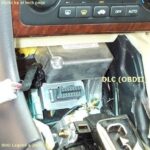Experiencing trouble connecting to your 2009 Nissan Altima’s OBD2 port? Many DIY mechanics and car owners encounter frustrating situations where their scan tools simply won’t communicate with their vehicle’s computer. This article dives into a real-world troubleshooting scenario, offering insights into diagnosing and potentially resolving OBD2 port connection issues on a 2009 Nissan Altima.
One common issue arises when seemingly everything checks out – power to pin 8 of the OBD2 port is present, grounds are confirmed, and continuity within the diagnostic communication lines (CAN L and CAN H) appears normal. Resistance readings at various points like the Data Link Connector (DLC), Engine Control Module (ECM), and Intelligent Power Distribution Module (IPDM) might also fall within expected ranges. Despite these seemingly positive checks, a connection with a scan tool remains elusive.
In such cases, a process of elimination becomes crucial. One insightful discovery involved disconnecting the ABS (Anti-lock Braking System) actuator/module connector. Surprisingly, this single action enabled successful communication with the car’s systems via the OBD2 port for the first time in a long while. This breakthrough raises several important questions and points towards potential problem areas.
Why would disconnecting the ABS module suddenly restore OBD2 port functionality? This points towards a potential fault within the ABS module itself or its related systems that might be interfering with the CAN bus communication network. The CAN bus is the communication backbone of modern vehicles, allowing various modules to exchange data. A malfunctioning module on this network can disrupt communication across the entire system, including preventing access through the OBD2 port.
Here are some key questions and considerations that arise from this troubleshooting experience:
Diagnostic App Compatibility and Module Specificity:
It’s observed that certain OBD2 apps are more effective than others. Apps like OBD Fusion and Car Scanner, which offer the flexibility to connect to specific modules individually or utilize a generic OBD protocol, proved successful in this case. This raises the question of whether some apps are better equipped to handle communication issues or module-specific diagnostics compared to more basic OBD2 apps like Torque Lite, OBD Mary, OBD Arny, Piston, Carly, and inCarDoc Free, which failed to connect in this scenario. Furthermore, even a wired OBD scanner initially failed, highlighting that the issue wasn’t solely Bluetooth related, but rather a deeper communication problem.
Is it normal for advanced apps to allow module-specific connection while generic OBD options might fail when there’s a communication issue? This behavior could be indicative of how different apps handle error conditions and communication protocols. Some might be more robust in isolating and bypassing issues to establish at least partial communication.
Root Cause and Potential Culprits:
The fact that reconnecting the ABS module after the initial successful connection didn’t immediately break the OBD2 communication again is interesting. This suggests that the initial disconnection might have reset something within the system, or that the ABS module issue is intermittent.
Could a malfunctioning ABS module, or even a faulty ABS sensor, be the root cause of OBD2 port communication problems in a 2009 Nissan Altima? While the vehicle in question didn’t exhibit typical ABS malfunction symptoms like speed reading errors or ABS performance issues, it’s plausible that an internal fault within the ABS module is disrupting the CAN bus.
If this issue resurfaces, identifying the exact culprit becomes paramount. Potential areas to investigate further include:
- ABS Module Malfunction: A failing ABS module could be sending erroneous signals or causing interference on the CAN bus.
- ABS Sensor Issues: Although less likely given the lack of ABS symptoms, a faulty ABS sensor or its wiring could potentially contribute to communication problems.
- CAN Bus Wiring Problems: While continuity checks were initially performed, intermittent wiring issues or corrosion within the CAN bus network could also be at play.
Moving Forward with Diagnostics:
For anyone facing similar OBD2 port connection problems on a 2009 Nissan Altima, this troubleshooting experience offers a valuable starting point. Disconnecting the ABS module connector is a relatively simple diagnostic step that could reveal if the ABS system is interfering with OBD2 communication.
If disconnecting the ABS module resolves the connection issue, further investigation of the ABS system is warranted. This might involve:
- Professional ABS Module Scan: Using a more advanced scan tool capable of reading ABS module-specific fault codes.
- ABS Module Inspection: Visually inspecting the ABS module and its connectors for any signs of damage or corrosion.
- Component Testing: Testing individual components within the ABS system, including sensors and wiring, if necessary.
In conclusion, diagnosing OBD2 port connection issues can be complex, but systematic troubleshooting and real-world experiences, like the one described, provide valuable insights. For 2009 Nissan Altima owners struggling to connect to their OBD2 port, considering the ABS module as a potential source of interference is a crucial step in the diagnostic process.
